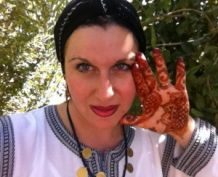
How Jazz Music Inspired Morocco’s Rebel Cinema of the 1970s
In this year’s program, the documentary festival with six Moroccan films, IDFA sheds light on scenes from the documentary film in the North African country and its artists. An excellent place for those looking to get acquainted with Moroccan film history is Ali Essafi’s latest film, “Before the Dying of the Light”, which received its international premiere in Amsterdam this week.
Using archival footage, jazz music, graphic novels and paraphernalia from the 1970s, “Before the Dying of the Light” tells the story of the birth of the Moroccan film industry and the challenges, battles that indigenous filmmakers fought against censorship.
The light died under the repressive leadership of King Hassan II, who turned against artists such as director Mostafa Derkaoui, who made the independent film “About Some Meaningless Events” (1974), and actress Leila Shenna, who played a female fatale in the 1979 Bond film “Moonraker” as an evil air hostess before disappearing without a trace in the 1980s.
The seventies were the last Moroccan period in which struggles and dreams for change were a reality. Also known as “Years of Lead” due to the violent repression that came along, this was the most important artistic and cultural period which shaped the first generation of Moroccan post-colonial artists.
Born in Fez in 1963, Essafi is one of Morocco’s leading documentary filmmakers, video artists and chroniclers, with a keen interest in outsiders who rebel against authoritarianism.
His previous films include “Crossing the Seventh Gate” (2017), an intimate portrait of the marginalized poet, filmmaker and writer Ahmed Bouanani (1938-2011), a director who remains something of a touchstone for Essafi, having discovered that Bouanani wrote notes about the history of Moroccan cinema for an unpublished manuscript, he has since collaborated with Bouanani’s daughter Touda, and a book is expected to be published soon.
“Before the Dying of the Light” has been a dream project for Essafi, who was working as a filmmaker in France when he first made the realization that he knew little about the history of cinema in his homeland. “I started researching this film 10 years ago,” he recalls, although he had his work cut out to find both the material and the classic films. “In Morocco, we don’t have access to archives,” he says. “So, I started doing everything I could to watch films made by the pioneers of Moroccan cinema. By chance, I knew a now-retired man, an engineer with a passion for cinema, [who] kept at his home everything about Moroccan film. It was like a real cinematheque in Morocco.”
The gem in this man’s collection was a VHS copy of “About Some Meaningless Events” which, at the time, was the only known copy of the film at the time in the world. And when the Sharjah Art Biennale directed Essafi to make a short film in 2011, he made a short film about Derkaoui, now 76, using parts from the VHS copy to talk about the director, who was sentenced to 33 years in jail after completing the movie.
That VHS copy set the Derkaoui renaissance in motion: after Essafi took it to the Cinémathèque de Tanger (CDT), as it was the only place in Morocco where he could share what he was finding, a woman working there began a search to locate an original print of the film. Long after she left the CDT, she found one in Spain, which was restored and played at the Berlinale in 2019. “Maybe if it wasn’t for that really bad VHS copy, no one today would hear about the film,” Essafi muse said.

Looking back, what’s remarkable about Moroccan cinema in the 1970s is the tremendous efforts that filmmakers would go to in order to make their films, despite the huge personal risk to themselves. In his film, Essafi cleverly tells the story about the secret screenings and banning of “About Some Meaningless Events” by weaving archive material with narration from Derkaoui, who was released 11 years into his sentence.
With its jazzy score, found footage and newsreel clips, Essafi’s documentary has a similar aesthetic to Göran Olsson’s 2011 doc “The Black Power Mixtape 1967-75.” It’s a film that Essafi praises a lot, and that jazz music links what was happening in the United States. with events in Morocco. “The model for revolutionary young people in Morocco was the emancipation of African Americans, so the jazz was a big part of this; it was a music of freedom. Young people until the beginning of the eighties listened a lot to jazz music.”
Essafi sent his film to Derkaoui, but he still doesn’t know what the leading director thinks of it yet, because, over the past years, the ageing director has lost his voice. “I’m sure he will not email anything to me, so I’m waiting to go back to Morocco to see him and get his reaction, as he writes on paper when he wants to communicate in person.”
Dedicated to the victims of censorship and oppression, “Before the Dying of the Light” evokes a time of excitement about the future, before it was extinguished by the repressive years by then. Now that flame is briefly rekindled as these images are shown once again.





